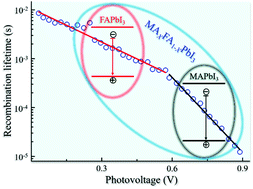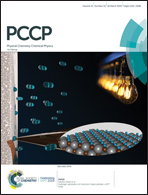Charge carrier recombination dynamics in a bi-cationic perovskite solar cell†
Abstract
The compositional engineering is of great importance to tune the electrical and optical properties of perovskite and improve the photovoltaic performance of perovskite solar cells. The exploration of the corresponding photoelectric conversion processes, especially the carrier recombination dynamics, will contribute to the optimization of the devices. In this work, perovskite with mixed methylammonium (MA) and formamidinium (FA) as organic cations, MA0.4FA0.6PbI3, is fabricated to study the influence of the bi-cation on the charge carrier recombination dynamics. X-ray diffraction analysis indicates the existence of the MAPbI3–FAPbI3 phase segregation in the bi-cationic perovskite crystal. The time-resolved photoluminescence dynamics presents a relatively fast carrier recombination process ascribed to the charge transfer from MAPbI3 to FAPbI3 in the bi-cationic perovskite film. The carrier recombination dynamics investigated by transient photovoltage measurements reveals a biphasic trap-assisted carrier recombination mechanism in the bi-cationic device, which involves carrier recombination in the MAPbI3 phase and FAPbI3 phase, respectively. The ultimate presentation of the carrier recombination process is closely related to the charge transfer between the two perovskite phases.

- This article is part of the themed collection: 2019 PCCP HOT Articles


 Please wait while we load your content...
Please wait while we load your content...